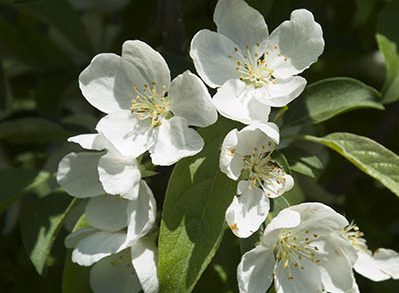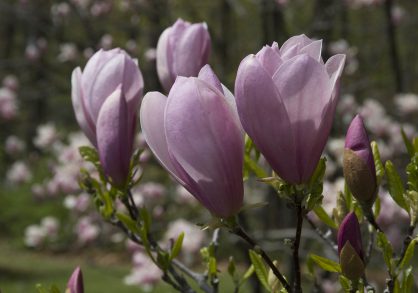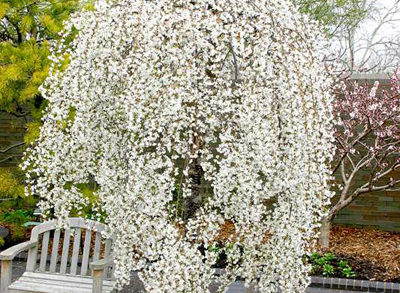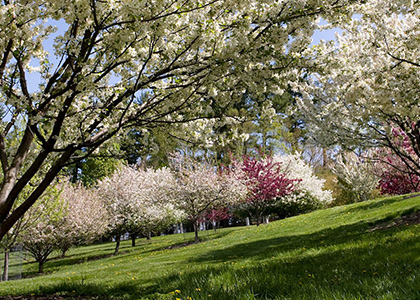
May is approaching, which brings our attention to the eye-catching blooms of ornamental apple, magnolia, and cherry trees sprinkled throughout the F. R. Newman Arboretum. Cherished for their striking blooms, these plants have acquired symbolic meanings in many cultures over thousands of years.
Ornamental Apples
Nearly all of Cornell Botanic Gardens’ 92 different types of apples (Malus sp.) are located within the Jennings Crabapple Collection and the Class of 1923 Flowering Tree collection.
In Celtic culture, apple flowers and fruits represent motherhood and maternal instinct. Bedchambers were decorated with apple blossoms as a fertility gesture and tribute to the beauty and bounty life provides.
Throughout Chinese history, symbolism has been integral to decorative arts. Ceramics depicting both crabapple flowers and peonies convey the phrase “mantang fugui,” which means “May the whole family achieve wealth and honor.”
During the 19th century, writers in France, England, and the U.S. created an elaborate “language” of flowers and published dictionaries of their sentimental meanings. Giving an apple blossom communicated your preference for the receiver.
Magnolias
The majority of the 38 magnolia varieties in Cornell Botanic Gardens’ collections are planted along the Arboretum Road, or within Jackson Grove.
White magnolias are commonly seen in bridal bouquets, especially in southern parts of the U. S., because the flowers are thought to reflect and emphasize the bride’s purity and nobility.
In ancient China, magnolias were thought to be the perfect symbols of womanly beauty and gentleness. They also symbolize loyalty and strength. Chinese Emperors were known to pay respect to loyal subjects by giving them magnolia flowers.
Ornamental Cherries
Seven varieties of cherries (Prunus sp.) are also found within the Flowering Tree Collection, and the remaining 13 varieties are dispersed throughout the F.R. Newman Arboretum and at the Nevin Welcome Center.
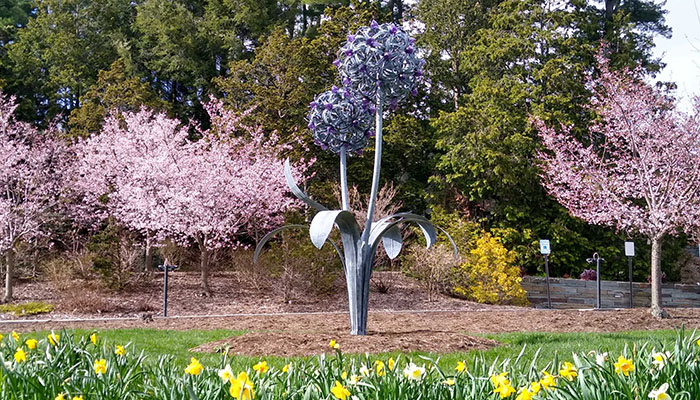
As Japan’s national flower, cherry blossoms, called “sakura,” are widely celebrated in Japanese culture. There are at least 15 species of flowering cherries native to Japan, with hundreds of varieties cultivated by humans over centuries.
Cherry blossom viewing has long been a popular Japanese pastime. Flower watching parties are known as “hanami.”
Cherry blossoms carry layered meanings, as reflected in art, poetry, and literature. Because of their short bloom time, they symbolize the ephemeral nature of life and they embody the Japanese philosophy of “wabi-sabi,” a world view centered on the acceptance of transience and imperfection, as well as gentleness and kindness.
Whether you are able to enjoy these spring flowering trees within the arboretum and gardens or from home, we invite you to take a closer look at these beautiful blossoms and reflect on what they mean to you.
EXPLORE FLOWERING TREES
Click the button below to explore a sampling of flowering apples, magnolias and cherries in our collections.
